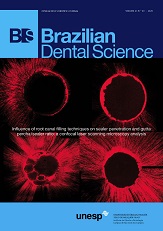Evaluation of the apical microleakage of MTA Fillapex, AH26, and Endofill sealers
DOI:
https://doi.org/10.14295/bds.2020.v23i3.1895Abstract
Objective: Proper apical seal plays an important role in the success of root canal treatment. The most common cause of failure of root canal therapy is known as the lack of adequate apical seal. The aim of this in vitro study was to compare the apical microleakage of MTA Fillapex, , and Endofill sealers using dye penetration method. Material and Methods: In this in vitro study, 72 single-rooted extracted human teeth were selected. The teeth were randomly divided into three experimental groups of 20 and two positive and negative control groups of 6. The canals were prepared by step-back technique and then filled with gutta-percha and one of the sealers mentioned. In the positive control group, the canals were filled with gutta-percha without sealer, and in the negative control group, the canals were prepared but not filled. The teeth were immersed in 2% methylene blue dye for 72 hours. The teeth were then cut longitudinally and the level of dye penetration was measured under a stereomicroscope. Data were analyzed by SPSS ver. 19 software, ANOVA and Bonferroni post-hoc tests. Results: The mean level of dye penetration in the Endofill test group was significantly higher than that in the and MTA Fillapex test groups. While, the observed difference between and MTA Fillapex groups was not statistically significant (p<0.05). Conclusion: The results of this study showed that and MTA Fillapex sealers did not show any significant difference in apical seal properties. However, their sealing strength was significantly greater than Endofill sealer.
Keywords
AH26 sealer; Endofill; MTA Fillapex; Microleakag
Downloads
Downloads
Additional Files
Published
How to Cite
Issue
Section
License
Brazilian Dental Science uses the Creative Commons (CC-BY 4.0) license, thus preserving the integrity of articles in an open access environment. The journal allows the author to retain publishing rights without restrictions.
=================




























